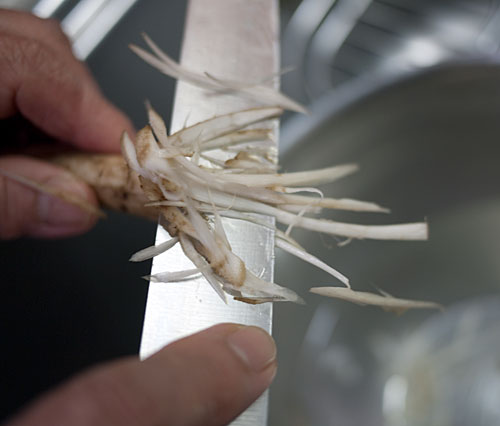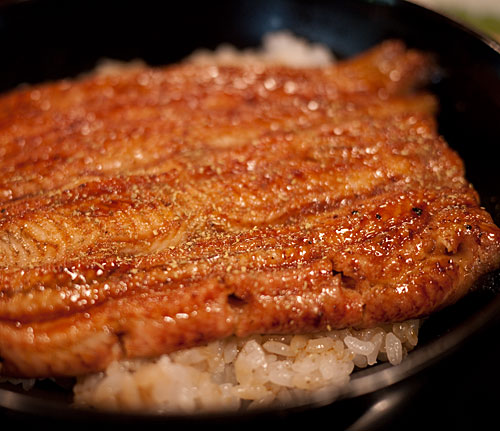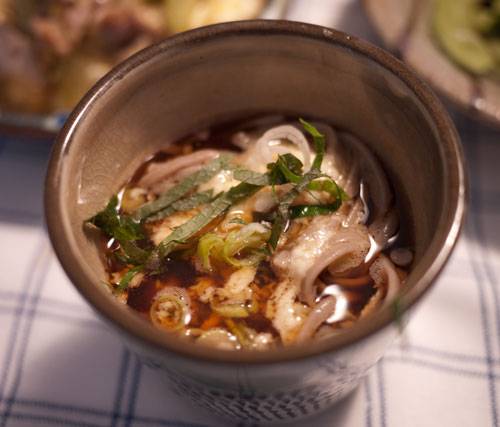
A new article in The Japan Times about winter fish, and how fish fits into a typical Japanese meal.
Filed under:
japanese fall winter fish japan seafood washoku in the media writing elsewhere japan times

Step-by-step instructions for making very thin shavings or doing the sasagaki cut on fibrous root vegetables like the burdock root or gobo.
Filed under:
basics japanese vegetables ingredients fall washoku knife skills burdock

A little slice of old Tokyo in an out-of-the-way area of Tokyo, Obana is an unagi-ya (eel restaurant) that even someone who's not an unagi fan can love.
Filed under:
food travel japanese restaurants japan washoku tokyo

This is a traditional satoimo or taro root recipe, where some of the root is used in the nutty sweet-savory sauce. It's a very 'fall' dish.
Filed under:
japanese vegetables fall vegetarian washoku

I have a new article in today's edition of The Japan Times, available online here, or in the print edition.
Filed under:
japanese rice onigiri japan washoku in the media writing elsewhere japan times

Here's a rather unusual (to Western tastes anyway) way to enjoy cold soba noodles - with slimy grated nagaimo root.
Filed under:
japanese offbeat noodles soba japan washoku tororo nagaimo slimy
A new article and recipe by yours truly is now available on The Japan Times web site, as well as in its print edition if you're in Japan. The subject this time is eggplants (aubergines). It also includes a recipe of course! The recipe combines delicious fall eggplants with a miso-meat sauce or sorts.
Incidentally, although the original recipe calls for thinly sliced beef, it works well with ground beef too. This is a shot of a version I made using ground beef.

This dish is great hot or cold, so make some for dinner and save a little for your bento the next day. Really yum!
Filed under:
japanese japan washoku in the media writing elsewhere japan times

One thing I'm really enjoying here in Japan is cooking simple things at home with my mother. To me, quintessential Japanese home cooking is a dish like this. Sardines, which happen to be quite inexpensive (and sustainable too), are slowly cooked until they are well flavored, meltingly soft, and glossy with a typically Japanese sweet-salty sauce. (The 'kanroni' (甘露煮) in the name refers to the method of simmering something in this sweet-salty sauce.) It uses just a few basic ingredients, so please give it a try if you can get a hold of very fresh sardines or similar oily fish. (The fish do have to be very fresh for this to be really good and not-fishy.)
I had a bit of a job working out this recipe, which comes from my mother, since she really doesn't measure anything when she makes this! After some trial and error, I think these ingredient amounts work well.
Filed under:
japanese fish washoku mom's recipes

It's been a cold and snowy winter so far around these parts, which usually means soups and stews for dinner. This classic Japanese soup is hearty yet low in calories, full of fiber, and just all around good for you. It helps to counteract all the cookies and sweets you might be indulging in at this time of year.
The name kenchinjiru (けんちん汁)derives from the Zen Buddhist temple where it was first made (or so it's claimed), Kencho-ji (建長寺)in Kamakura. (Kamakura (鎌倉) was, for a brief while, the capital of Japan in the 12th and 13th centuries. Nowadays it's a major historical tourist attraction, and a fairly easy day trip from central Tokyo.) Since kenchinjiru is a shojin ryouri or temple cuisine dish, the basic version given here is vegan. It's still very filling because of all the high fiber vegetables used. You could make a very satisfying vegan meal just from this soup and some brown rice.
Filed under:
japanese lighter soup winter vegetarian favorites vegan washoku shojin
 When a Japanese person dreams of quitting his or her rat-race job and opening a restaurant, the type of restaurant they usually envision is either a kissaten or kafe (a café-restaurant) or an izakaya. An Izakaya (居酒屋)is a small traditional pub that serves food, rather like a Spanish tapas bar. Many are quite tiny, with just the counter and maybe a few tables. The best ones are run with a lot of passion and love, and have fiercely loyal customers.
When a Japanese person dreams of quitting his or her rat-race job and opening a restaurant, the type of restaurant they usually envision is either a kissaten or kafe (a café-restaurant) or an izakaya. An Izakaya (居酒屋)is a small traditional pub that serves food, rather like a Spanish tapas bar. Many are quite tiny, with just the counter and maybe a few tables. The best ones are run with a lot of passion and love, and have fiercely loyal customers.
Izakaya, the Japanese Pub Cookbook conveys the atmosphere and love of food and good sake that are hallmarks of good izakaya perfectly. Written by Mark Robinson, an Australian journalist who fell in love with izakaya establishments in Tokyo, with gorgeous photography in both color and black and white by Masashi Kuma, it is part cookbook and part ode to the cult of the izakaya. You don't just get recipes here, even though it's called a cookbook. There are profiles of izakaya masters, useful advice on izakaya etiquette, notes on sake types, anecdotes and a lot more. I think it can reside as happily on a bedside table as in the kitchen - a quality I look for when I buy cookbooks.
Filed under:
books and media japanese washoku
Pages